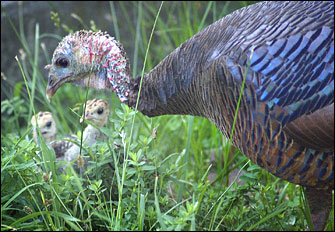Wild Turkeys Thriving at BNL
November 26, 2008

Wild turkeys at BNL
Most Americans enjoy turkey with stuffing, cranberries and all the trimmings at Thanksgiving, but the wild turkeys at the Brookhaven Lab site won't be on the menu. The turkeys on site are healthy and thriving, but they can't be hunted for two reasons - hunting is not allowed at BNL, and all Long Island wild turkeys are protected by the New York State Department of Environmental Conservation (NYSDEC), which has banned turkey hunting on Long Island in order to bring the dwindling population of birds back to the area.
In the early 1990s, the NYSDEC transported 49 turkeys to Southaven Park in Shirley to reestablish the birds in the area, and many of those birds migrated to BNL. Judging by the number of wild turkeys on site nowadays, the NYSDEC program has been extremely successful.
"We have an estimated 300 to 500 wild turkeys on site," said zoologist Tim Green, the BNL Cultural and Natural Resources Manager. "The DEC no longer has to transport them around the county - many of the turkeys have migrated on their own all over Suffolk County. In fact, the population is so large that the DEC may lift the ban on hunting the birds next year."
Wild turkeys live about six or seven years, and they eat a wide variety of plants and insects, as well as acorns, fruits, oats, seeds, and even manure in agricultural areas. They can fly up to about 1,000 yards at a speed as high as 55 miles per hour, and they can run up to 12 miles per hour. The turkey breeding season runs from the end of March through mid-June, and during this time, the toms perform courtship displays, fluffing their feathers, dragging their wings, and gobbling. The hen nests by herself, most often in a wooded area. While wild turkeys usually do not bother humans, if they are disturbed during breeding season, they may attack the intruder.
"It is best to keep your distance from wild turkeys, and don't feed them," Green warned.
2008-987 | INT/EXT | Newsroom









